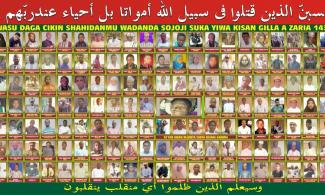
Last December, Human Rights Watch (HRW) published a damning report regarding the evidence of mass graves in Zaria as well as estimating that at least 300 people were killed in the massacre.
In a Facebook post released on Monday, the Islamic Movement of Nigeria (IMN) released the names of 705 of their members they claim have been missing since the military slaughtered hundreds of Shiites in December 2015. The social media post stated that the list was preliminary, as the fates of many believed to be killed or abducted by the military remains unclear.

In addition to a full list of names, the post also included a poster depicting several of the missing IMN members, as well as disturbing photos of those injured during the massacre.
On December 12 members of the IMN clashed with the Nigerian Army on the streets of Zaria in Kaduna State. The military claimed that members of IMN set up a roadblock in an attempt to trap and then assassinate Army Chief of Staff Lt. General Tukur Buratai. However, the IMN said that they were merely holding a peaceful protest.
Two days after the massacre, SaharaReporters obtained a video depicting a pile of dead Shiite Muslims stacked along a street in Zaria which were being looted by passersby.
On top of the killing hundreds of Shiites, the army also captured the leader of IMN Sheikh Ibrahim Zakzaky after laying siege to his home for 11 hours. Grim photos subsequently emerged of Sheikh Zakzaky badly wounded and plopped into a wheelbarrow by Nigerian soldiers. More photos later emerged of Nigerian authorities destroying the home, properties, and important Shiite sites by fire or turning them into rubble.
Sheikh Zakzaky is believed to be enroute to France for medical treatment of the wounds he received during the siege, according to media reports. Relatives speaking with SaharaReporters have said that it took weeks before they knew the details of Sheikh Zakzaky’s condition and location.
As details emerged regarding the massacre, several human rights organizations and foreign governments issued condemnations of the Nigerian military. The US government called upon President Muhammadu Buhari to launch an independent probe into the actions taken by the Nigerian Army.
Last December, Human Rights Watch (HRW) published a damning report regarding the evidence of mass graves in Zaria as well as estimating that at least 300 people were killed in the massacre.
“At least 300 Shia sect members, and likely many more, were killed and hundreds more injured, according to witnesses in at least two of the sites and a hospital source.
“Soldiers quickly buried the bodies in mass graves without family members’ permission, making it difficult to determine an accurate death toll,” the report read in part.
The military and Kaduna State government have announced that they are investigating the circumstances of the massacre. However, activists have stated that they do not trust the outcome of these investigations--particularly having the military investigate itself and its Chief of Staff.